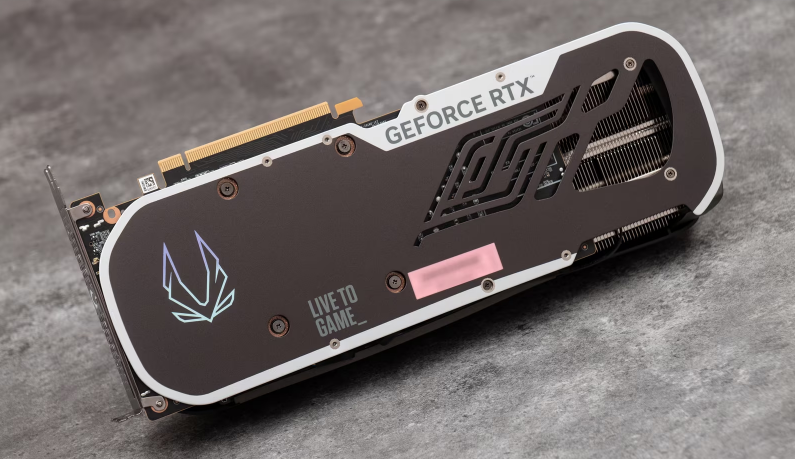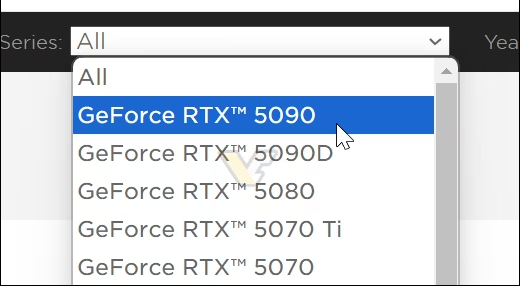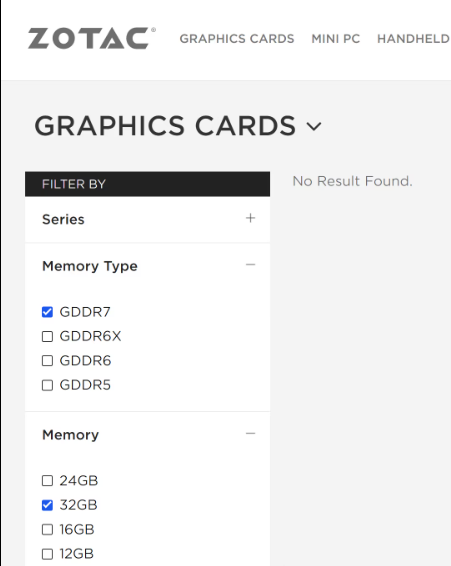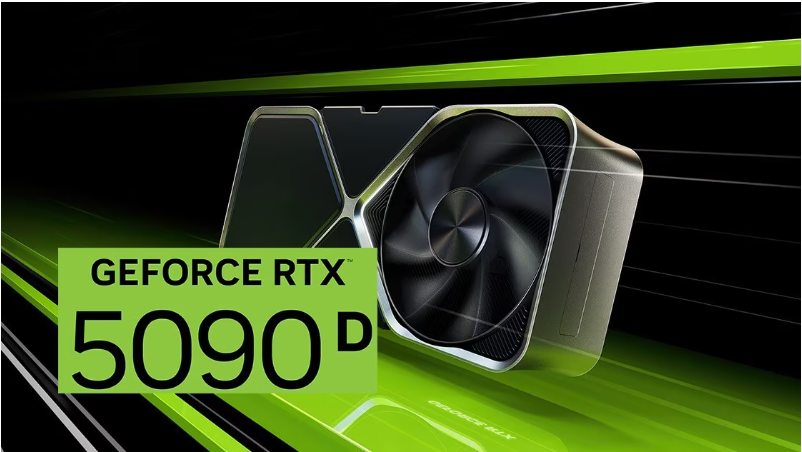 Operation and Maintenance
Operation and Maintenance
 Nginx
Nginx
 RTX50 series is coming. Sotai confirmed that 5090 is equipped with 32GB GDDR7 video memory and solid materials
RTX50 series is coming. Sotai confirmed that 5090 is equipped with 32GB GDDR7 video memory and solid materials
RTX50 series is coming. Sotai confirmed that 5090 is equipped with 32GB GDDR7 video memory and solid materials
Apr 13, 2025 pm 11:09 PMThe well-known hardware leaked website VideoCardz recently discovered the information of the GeForce RTX 50 series graphics card that NVIDIA will release at the CES 2025 exhibition on the official website of Sotai, which partially confirms the previous rumors.


GeForce RTX 50 series product line
The flagship model GeForce RTX 5090 is expected to be equipped with up to 32GB of GDDR7 video memory, a specification not available in the RTX 40 series. In addition, the exclusive model GeForce RTX 5090D in mainland China will also be launched.

VideoCardz also found models such as the RTX 5080, RTX 5070 Ti and RTX 5070, which are expected to be released alongside the RTX 5090, but the time to market may vary.

It is worth noting that since no RTX 5080D model was found, it is speculated that its performance may be lower than the standards of the U.S. government export restrictions to China.
Given the U.S. restrictions on exports of high-performance AI computing devices to China, and the recently exposed RTX 5090D trademark design, the RTX 50 series graphics cards may also face the same restrictions. The whistleblower @Zed__Wang shared the trademark picture of RTX 5090D on the X platform. The design style with green background and black letters may be used on the packaging boxes of various manufacturers. If true, this means that the standard version of the RTX 5090 will not be launched in the mainland Chinese market, similar to the situation where the RTX 4090 was forced to be discontinued due to the ban.

On the other hand, NVIDIA once said that the "D" in the graphics card model represents "Dragon" (dragon), which corresponds to the Chinese Lunar Dragon Year. If true, the RTX 50 series will meet you before the Lunar New Year.
The above is the detailed content of RTX50 series is coming. Sotai confirmed that 5090 is equipped with 32GB GDDR7 video memory and solid materials. For more information, please follow other related articles on the PHP Chinese website!

Hot AI Tools

Undress AI Tool
Undress images for free

Undresser.AI Undress
AI-powered app for creating realistic nude photos

AI Clothes Remover
Online AI tool for removing clothes from photos.

Clothoff.io
AI clothes remover

Video Face Swap
Swap faces in any video effortlessly with our completely free AI face swap tool!

Hot Article

Hot Tools

Notepad++7.3.1
Easy-to-use and free code editor

SublimeText3 Chinese version
Chinese version, very easy to use

Zend Studio 13.0.1
Powerful PHP integrated development environment

Dreamweaver CS6
Visual web development tools

SublimeText3 Mac version
God-level code editing software (SublimeText3)

Hot Topics
 The popularity of the currency circle has returned, why do smart people have begun to quietly increase their positions? Look at the trend from the on-chain data and grasp the next round of wealth password!
Jul 09, 2025 pm 08:30 PM
The popularity of the currency circle has returned, why do smart people have begun to quietly increase their positions? Look at the trend from the on-chain data and grasp the next round of wealth password!
Jul 09, 2025 pm 08:30 PM
As the market conditions pick up, more and more smart investors have begun to quietly increase their positions in the currency circle. Many people are wondering what makes them take decisively when most people wait and see? This article will analyze current trends through on-chain data to help readers understand the logic of smart funds, so as to better grasp the next round of potential wealth growth opportunities.
 What are the mainstream public chains of cryptocurrencies? The top ten rankings of cryptocurrency mainstream public chains in 2025
Jul 10, 2025 pm 08:21 PM
What are the mainstream public chains of cryptocurrencies? The top ten rankings of cryptocurrency mainstream public chains in 2025
Jul 10, 2025 pm 08:21 PM
The pattern in the public chain field shows a trend of "one super, many strong ones, and a hundred flowers blooming". Ethereum is still leading with its ecological moat, while Solana, Avalanche and others are challenging performance. Meanwhile, Polkadot, Cosmos, which focuses on interoperability, and Chainlink, which is a critical infrastructure, form a future picture of multiple chains coexisting. For users and developers, choosing which platform is no longer a single choice, but requires a trade-off between performance, cost, security and ecological maturity based on specific needs.
 Bitcoin breaks new highs, Dogecoin rebounds strongly, will Ethereum keep up with the pace
Jul 09, 2025 pm 08:24 PM
Bitcoin breaks new highs, Dogecoin rebounds strongly, will Ethereum keep up with the pace
Jul 09, 2025 pm 08:24 PM
Recently, Bitcoin hit a new high, Dogecoin ushered in a strong rebound and the market was hot. Next, we will analyze the market drivers and technical aspects to determine whether Ethereum still has opportunities to follow the rise.
 There are too many slanderous stories in the currency circle? Understand the key logic and risk control secrets in one article!
Jul 09, 2025 pm 08:33 PM
There are too many slanderous stories in the currency circle? Understand the key logic and risk control secrets in one article!
Jul 09, 2025 pm 08:33 PM
The currency circle seems to have a low threshold, but in fact it hides a lot of terms and complex logic. Many novices "rush into the market" in confusion and end up losing money. This article will give a comprehensive explanation of common terms in the currency circle, the operating logic of real money makers, and practical risk control strategies to help readers clarify their ideas and reduce investment risks.
 Cardano's smart contract evolution: The impact of Alonzo upgrades on 2025
Jul 10, 2025 pm 07:36 PM
Cardano's smart contract evolution: The impact of Alonzo upgrades on 2025
Jul 10, 2025 pm 07:36 PM
Cardano's Alonzo hard fork upgrade has successfully transformed Cardano from a value transfer network to a fully functional smart contract platform by introducing the Plutus smart contract platform. 1. Plutus is based on Haskell language, with powerful functionality, enhanced security and predictable cost model; 2. After the upgrade, dApps deployment is accelerated, the developer community is expanded, and the DeFi and NFT ecosystems are developing rapidly; 3. Looking ahead to 2025, the Cardano ecosystem will be more mature and diverse. Combined with the improvement of scalability in the Basho era, the enhancement of cross-chain interoperability, the evolution of decentralized governance in the Voltaire era, and the promotion of mainstream adoption by enterprise-level applications, Cardano has
 Who issues stablecoins? What are the stablecoins?
Jul 09, 2025 pm 06:24 PM
Who issues stablecoins? What are the stablecoins?
Jul 09, 2025 pm 06:24 PM
Stablecoins are crypto assets that maintain price stability by anchoring fiat currencies such as the US dollar. They are mainly divided into three categories: fiat currency collateral, crypto asset collateral and algorithmic stablecoins. 1. USDT is issued by Tether and is the stablecoin with the largest market value and the highest liquidity. 2. USDC is released by the Centre alliance launched by Circle and Coinbase, and is known for its transparency and compliance. 3. DAI is generated by MakerDAO through over-collateralization of crypto assets and is the core currency in the DeFi field. 4. BUSD was launched in partnership with Paxos, and is regulated by the United States but has been discontinued. 5. TUSD achieves high transparency reserve verification through third-party escrow accounts. Users can use centralized exchanges such as Binance, Ouyi, and Huobi
 Leading the top 20 token rankings in the 2025 crypto market (Latest update)
Jul 10, 2025 pm 08:48 PM
Leading the top 20 token rankings in the 2025 crypto market (Latest update)
Jul 10, 2025 pm 08:48 PM
The top 20 most promising crypto assets in 2025 include BTC, ETH, SOL, etc., mainly covering multiple tracks such as public chains, Layer 2, AI, DeFi and gaming. 1.BTC continues to lead the market with its digital yellow metallicity and popularization of ETFs; 2.ETH consolidates the ecosystem due to its position and upgrade of smart contract platforms; 3.SOL stands out with high-performance public chains and developer communities; 4.LINK is the leader in oracle connecting real data; 5.RNDR builds decentralized GPU network service AI needs; 6.IMX focuses on Web3 games to provide a zero-gas-free environment; 7.ARB leads with mature Layer 2 technology and huge DeFi ecosystem; 8.MATIC has become the value layer of Ethereum through multi-chain evolution
 Comparison of the differences and advantages and disadvantages of USDC, DAI, and TUSD (recently updated)
Jul 10, 2025 pm 09:09 PM
Comparison of the differences and advantages and disadvantages of USDC, DAI, and TUSD (recently updated)
Jul 10, 2025 pm 09:09 PM
The core difference between USDC, DAI and TUSD lies in the issuance mechanism, collateral assets and risk characteristics. 1. USDC is a centralized stablecoin issued by Circle and is collateralized by cash and short-term treasury bonds. Its advantages are compliance and transparent, strong liquidity, and high stability, but there is a risk of centralized review and single point failure; 2. DAI is a decentralized stablecoin, generated through the MakerDAO protocol, and the collateral is a crypto asset. It has the advantages of anti-censorship, transparency on chain, and permission-free, but it also faces systemic risks, dependence on centralized assets and complexity issues; 3. TUSD is a centralized stablecoin, emphasizing real-time on-chain reserve proof, providing higher frequency transparency verification, but has a small market share and weak liquidity. The three are collateral types and decentralization





